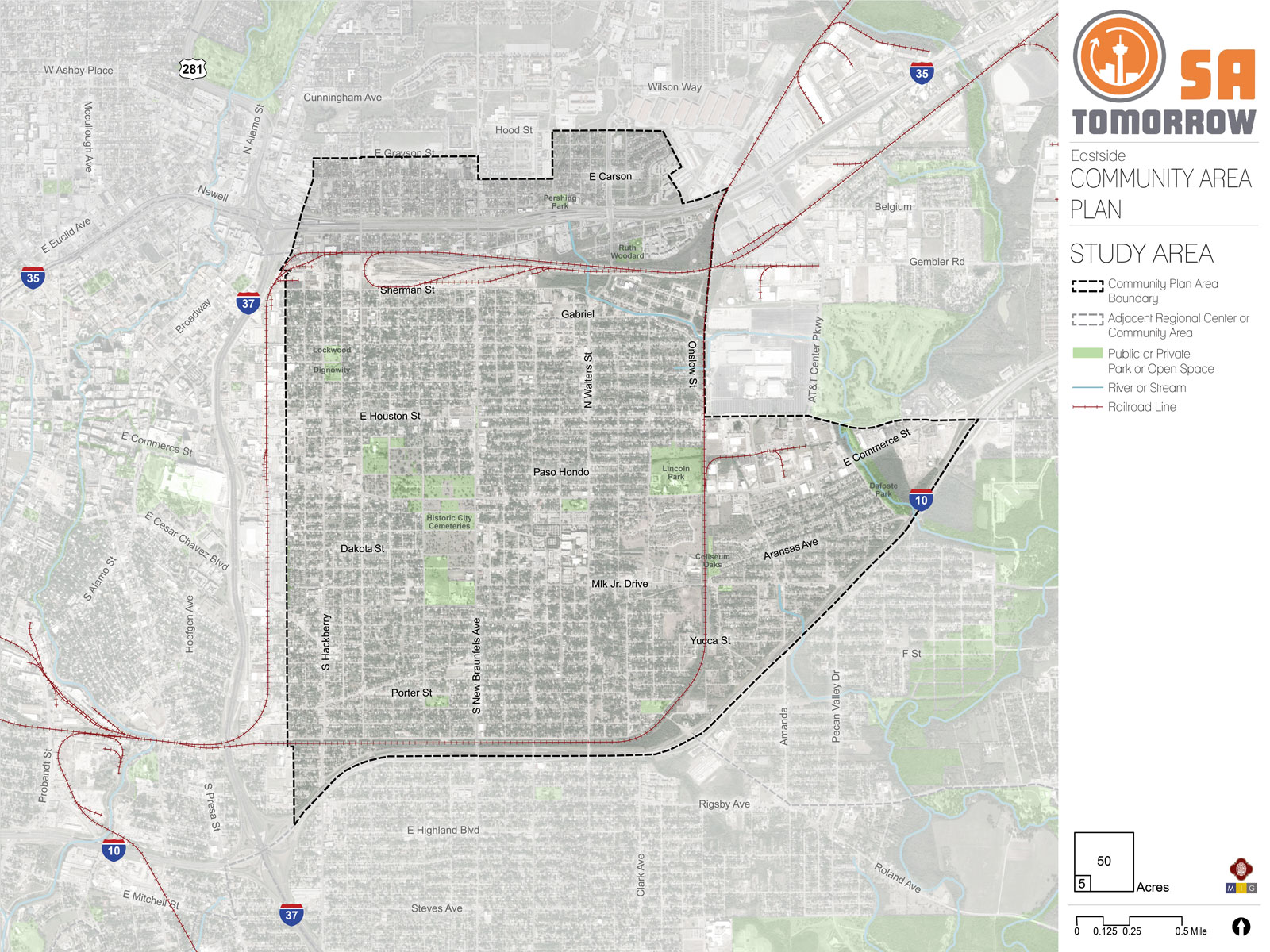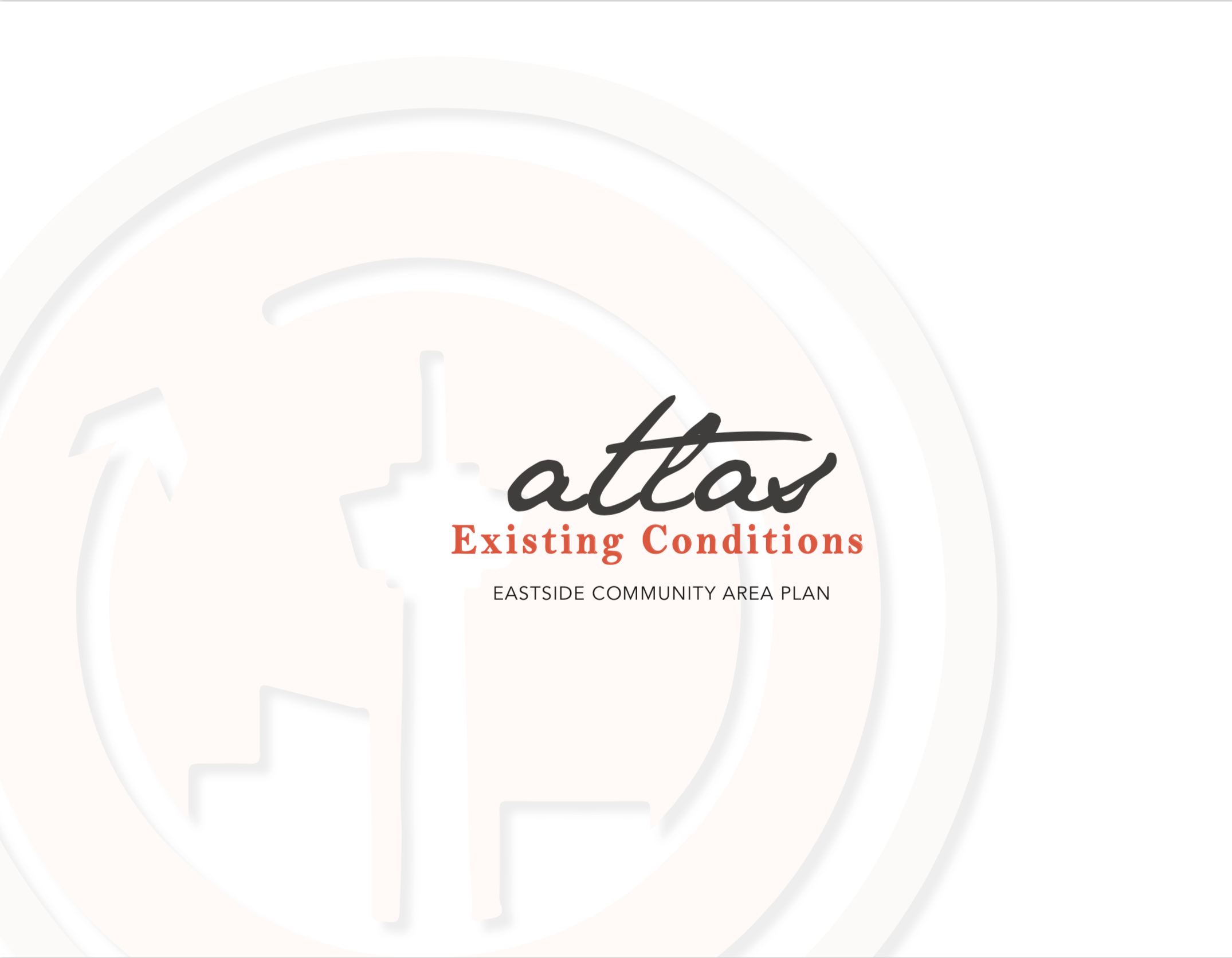Existing Conditions
Eastside Community Area
Explore the tabs below to learn more about the assets, challenges and opportunities in the Eastside Area and to view our study area map.
The map below shows the Eastside Regional Center Area in relationship to San Antonio. The area is highlighted in black.
View Full Size
Assets
Throughout the process of creating the Eastside Area Community Plan, Eastside stakeholders referred to the area’s history and culture as its primary assets. The Eastside Area includes places and physical characteristics that are uniquely connected to the area’s history and culture, that Eastsiders identify with, and that can be considered ingredients for a good quality of life for present and future generations. The gridded street network historically enabled residents to travel short distances to obtain goods and services close to home. Typical neighborhood development patterns and residential architectural styles, established prior to World War II, are not only subjectively appealing to Eastsiders, they have functional characteristics that support walking and engagement between neighbors.
Beyond these fundamentally important assets, the Eastside Area includes countless places, landmarks, and institutions that serve as reminders of history and that can assist in telling important stories about the past; they help maintain culture and identity. Many of these assets are referred to in other sections of the Eastside Area Community Plan, as they form the basis for making recommendations for a future that respects the past and builds on its strengths.
Challenges
Eastside residents on average have lower incomes, less education, and poorer health outcomes than San Antonio residents as a whole have on average. There are fewer employers, goods, and services located close to Eastside Area neighborhoods than in some other parts of the city. For several decades, public and private investment lagged behind other areas of the city, resulting in infrastructure that doesn’t reflect current aspirations, and more deterioration in homes and other buildings.
The supply of housing has not kept up with the number of people who want to live on the Eastside, leading to increasing property values, and challenging some residents’ ability to afford the costs of taxes, home maintenance, and rent. Growing economic opportunity for less educated or lower wage workers has not kept pace with the increasing costs of housing and transportation.
Opportunities
In the Eastside there are opportunities to leverage at least three primary assets toward achieving the plan’s Vision and Goals. In the Eastside Area more so than many other parts of San Antonio, there are opportunities to enhance transportation choices and the quality of local places for small businesses and pedestrians, leveraging the area’s dense interconnected network of streets and sidewalks. The Eastside has momentum toward achieving some long standing economic development and quality of life goals that this plan recommits to, and doing so in a way that draws inspiration from and pays respect to the area’s positive historical characteristics. There is a network of community organizations, from economic development groups, to neighborhoods associations, church congregations, and social service agencies that can affect more positive change in community placemaking, housing affordability, and the built environment. This plan includes recommendations that would empower more local organizations to contribute in these areas.
The map below shows the Eastside Regional Center Area Plan boundary and the connectivity throughout the area and beyond.
View Full Size
Sub-Area Plans
Sub-Area Plans are intended to provide a more coordinated, efficient and effective structure for neighborhood planning. Existing and future neighborhood planning will be integrated into the planning for regional centers and community planning areas. Neighborhoods will become integral sub-geographies of these sub-areas while also receiving special attention through chapters and/or sections in each Sub-Area plan, reflecting specific opportunities, challenges, recommendations and priorities from each participating neighborhood. Neighborhood and community plans should be respected, as appropriate, as they are integrated into the sub-area plans.
Comprehensive Plan Community Areas

Community Areas form the rest of San Antonio outside of the Regional Centers. These areas comprise many of our existing neighborhoods, grouped by geography and common history, challenges, and opportunities. By proactively directing a higher proportion of growth to our Regional Centers, we aim to limit the impacts of that growth on existing, stable neighborhoods. However, cities and neighborhoods are always evolving, and we must plan to adapt to and leverage change for all our existing and future residents by creating complete neighborhoods and communities that provide a full range of amenities and services, a variety of housing and transportation choices, and opportunities for employment, shopping, education, and recreation.




.jpg)








.jpg)